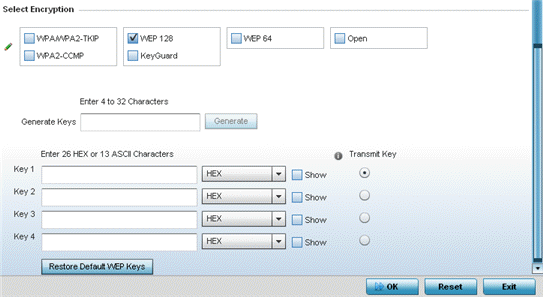WEP 128
About this task
WEP can be used with open, shared, MAC and 802.1 X EAP authentications. WEP is optimal for WLANs supporting legacy deployments when also used with 802.1X EAP authentication to provide user and device authentication and dynamic WEP key derivation and periodic key rotation. 802.1X provides authentication for devices and also reduces the risk of a single WEP key being deciphered. If 802.1X support is not available on the legacy device, MAC authentication should be enabled to provide device level authentication.
WEP 128 and Keyguard use a 104-bit key which is concatenated with a 24-bit IV (initialization vector) to form the RC4 traffic key. WEP may be all a small-business user needs for the simple encryption of wireless data. However, networks that require more security are at risk from a WEP flaw. WEP is recommended only when there are client devices incapable of using higher forms of security. The existing 802.11 standard alone offers administrators no effective method to update keys.
WEP 128 or Keyguard provides a more robust encryption algorithm than WEP 64 by requiring a longer key length and pass key. Thus, making it harder to hack through the replication of WEP keys.
To configure WEP 128 encryption on a WLAN:
Procedure
What to do next
- Additional layers of security (beyond WEP) should be enabled to minimize the likelihood of data loss and security breaches. WEP enabled WLANs should be mapped to an isolated VLAN with firewall policies restricting access to hosts and suspicious network applications.
- WEP enabled WLANs should be permitted access only to resources required by legacy devices.
- If WEP support is needed for WLAN legacy device support, 802.1X EAP authentication should also be configured in order for the WLAN to provide authentication and dynamic key derivation and rotation.




